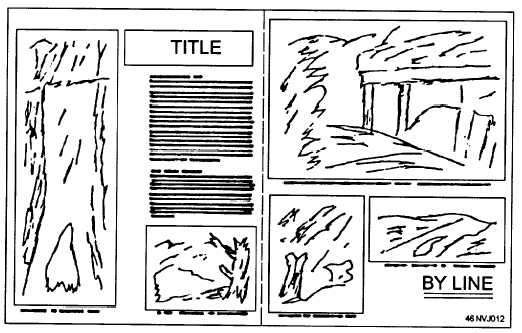be affected by continuity of photographs from page to
layout. By knowing layout size and using a thumbnail
page or by extending a photograph or title across the
sketch to determine relative size, you can determine
gutter (margins between pages).
the exact size to print the photographs.
Photographs for a picture story or picture essay
should be edited until only the photographs required
to tell the story remain. You must decide what
number of photographs to use for the story as well as
what form of composition to use. Often, the content
of the photographs will assist you in making decisions
about the compositional form.
As discussed previously, the lead photograph in a
picture story or essay should be "eye catching" and
create impact. The lead photograph does not have to
be placed in the primary optical area; however, it
should be placed in the layout so it sets the theme for
the story. Similarly, the end or closing photograph
should produce a feeling that the story has ended.
After the photographs are selected for story-telling
content, you should construct thumbnail sketches to
assist in determining the best layout for that particular
story. A thumbnail sketch is a rough sketch idea of
the layout. You may have to construct several
thumbnail sketches before deciding on the best layout
(fig. 1-8).
You should crop the photographs on an easel
during printing, and print them to correct size for the
When cropping is required after the photograph is
printed, you should place a sheet of thin paper over
the photograph. Mark the thin paper, rather than the
photograph, with crop marks. Crop marks are lines or
dashes, in pencil, that indicate where to crop the
photograph.
SCALING
Scaling is the procedure whereby you calculate the
size that a photograph is to be reduced or enlarged.
The simplest method for scaling your pictures is to
use a common diagonal. Place a sheet of tracing
paper over the picture being scaled and draw a
diagonal line on the paper over the picture or where
the crop marks are indicated. Determine the size of
the finished picture along the bottom. Now raise a
perpendicular line until it meets the diagonal line; this
is the height of the finished picture.
When you use the diagonal method of scaling,
everything that is in the original print, or indicated
within the crop marks, will be in the scaled
reproduction.
Figure 1-8.—Thumbnail sketch for a double-page layout.
1-21



